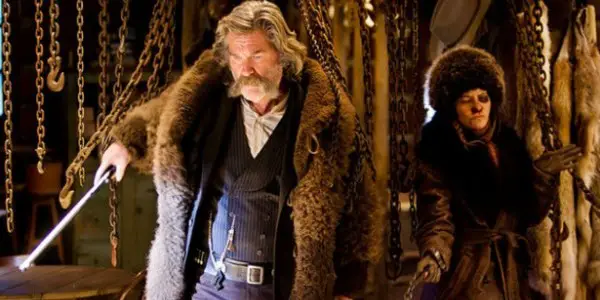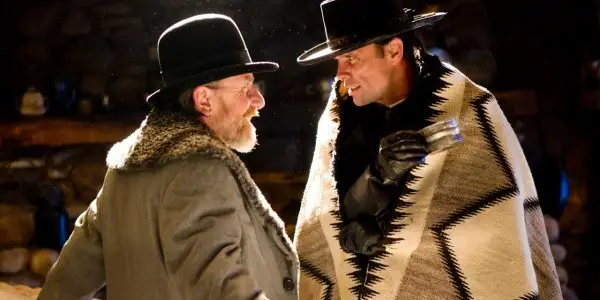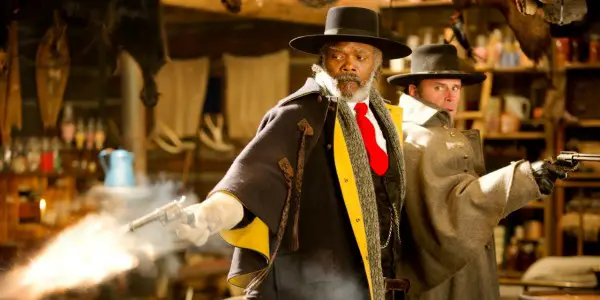THE HATEFUL EIGHT: Cinema At Its Most Sadistic

A bi-product of passion and experimentation gone wrong, Mike has…
There is none righteous, not even one. — Romans 3:10
Film is a memory machine. It’s a teleportation device to the past, recalling history and reminding us of ages that have been trampled upon by new days and dark nights. At its best, films should hold a mirror up for society to look upon where it’s been, where it’s at and potentially where it’s going.
This is the post-modern era, where all pop references are reflections of something else already grounded in cultural institutions, as seen by the unparalleled success of Star Wars: The Force Awakens. That movie is a hard-reboot of A New Hope, featuring a few new characters and constant fanfare winks and nods, lacking creative originality, with contextual clichés. It’s a low-point in contemporary narrative traditions.
Barreling into the discussion, with guns loaded, in an attempt to alter the sugary and anti-intellectual views and discourse on pastiche, comes Quentin Tarantino’s revisionist Western, The Hateful Eight. The title is a subversion of one the most recognizable Westerns, The Magnificent Seven, which was a Hollywood remake of Akira Kurosawa’s Seven Samurai. Incidentally, The Hateful Eight is Tarantino’s eighth movie.
The title implies the abandonment of all things righteous, and brother, is it as dour and bleak as a story gets. It also seemed to prophetically anticipate the reactions of some, as “hate” is the word that most people use to describe displeasure with things. The Hateful Eight doesn’t boast any of the retro sights and sounds that have become synonymous with the Tarantino label, instead it revises the vision of his previous two films, by exploring ungodly debauchery and the myth of the West. It is the real side of humanity that Tarantino is after, and it arrives in the grandest of fashions.
Seeing Pictures
The road traversing The Hateful Eight was an arduous and treacherous one that nearly wasn’t taken at all. In January 2014, Tarantino’s first draft for the film was leaked online and Tarantino professed he wouldn’t even do the project. But a few months later the auteur gathered a full cast, most of whom are in the final cut, and did a live reading of the script in Hollywood. It was a sold-out venue and Tarantino had such a blast with it that it encouraged him to finish the next two drafts he had envisioned and to move forward into production.

Somewhere along the way he got the idea for shooting the film on 70mm and met up with Panavision to discuss displaying the movie in that format at specific venues. While at their facilities, Tarantino and Director of Photography, Robert Richardson, stumbled upon the the Ultra Panavsion lenses that hadn’t been used in over half a century, the same set of lenses used on such epics as Ben-Hur. This was the germination in Tarantino’s mind to do something to and with film that hadn’t been done in decades, and it would be the greatest retrospective about film.
Current moviemaking ideology relies solely on a longing nostalgia for a glorified past. Hollywood is driven by franchises and tentpoles (films that financial support the studio) that have clearly defined heroes with extraordinary powers. It’s a digital medium and a sterile environment, and Tarantino has had his fill of it. The Hateful Eight is a self-aware metacritique of contemporary Hollywood, and the point of being lucidly conscious is that one understands his or her place in history, and can act accordingly from an insightful perspective.
Basically, what Tarantino is doing is going back to the truest essence of film and turning all expectation for characters, story, settings and aesthetic form on their heads and offering the sharpest method of presenting a film.
In the roadshow version, which is an actual 70mm projection, the film has an overture and twelve minute intermission that runs almost in real-time to the events in the picture. It’s an elongated structure that helps place the importance on taking the time with the craft, much like an opera or mythic tale. The roadshow version is vastly superior to the digital cut, and as any cinephile should attest to, this is an overdue cinematic event on which to geek-out on and lose one’s mind over.
Instead of being bigger like IMAX, the 70mm is wider in length and boasts a huge color palate. There is the capacity to put more into frame but, ironically, this tale is a small one. On the tech side, if one were to transfer it to a digital format it would immediately have a 6K resolution. That’s how insanely vivid 70mm is.

Undeniably, The Hateful Eight is one hell of a gorgeous film. Every composition lends to the perfect timing and editing transitions between them. It’s framed expertly, bordering on the best shot film in all of Tarantino’s filmography, and that’s saying a lot. Considering this is mostly a one-setting narrative, Quentin and Richardson block the characters perfectly. They are able to create a world with enough space while also, without the sense of being gimmicky, populating their shots with an economy only found in motion pictures. Tarantino knows exactly where and when to show specific people and when to let them wade in the shadows ready to strike out.
Slowing It Down, Slowing It Way Down
The Hateful Eight is a body horror movie in the garb of a Western. It’s very loosely a remake of Stagecoach, while also being part Agatha-Christie-whodunit, with murder and intrigue at the center of the plot. The movie openly hides what it truly is the same way a lot of the characters hide their identities and motivations.
In part, the haunting score by Ennio Morricone is reminiscent of another Morricone score for The Thing. Also starring Kurt Russell, The Thing was an existential horror film that interrogated and discounted the qualifiers of humanity. Similarily, The Hateful Eight is a philosophical, Cartesian examination of the darkest parts of humanity and postulates the nature of humankind is a monstrosity. Every single person in the film is a terrible human being with extreme prejudices, malice, and zero redeeming qualities.
Major Marquis Warren (Samuel L. Jackson) is a bounty hunter who hops aboard a stagecoach headed for Red Rock in the Wyoming territory. Already having purchased a seat, John Ruth “The Hangman” (Kurt Russell) is tranporting his bounty, Daisy Domergue (Jennifer Jason Leigh), to that destination as well. Ruth begrudgingly lets Warren on the stagecoach and the three travel to Minnie’s Habberdashery where they encounter Sheriff Chris Mannix (Walton Gogggins), Bob (Demián Bichir), Oswaldo Mobray (Tim Roth), Joe Gage (Michael Madsen), and General Sandy Smithers (Bruce Dern), all of whom are hiding something sinister or have done disreputable things in the past. It’s easy to foresee that once all the parties involved meet up at Minnie’s, a descent into fiery gunplay soon unfolds.

The Hateful Eight is almost a religious piece, starting off with an early shot of the stagecoach passing by a huge crucifix with a dying Jesus on it. This signifies a plunge into hell, as if Tarantino is making an adaptation of Dante’s “Inferno” and letting the viewers know that the film is abandoning all hope and morality. The characters are going into extreme physical torment and mental anguish and it’s by their own corrupted hands.
The lack of a moral center, or a character, is the revision that Tarantino is performing on his previous vision of the western, seen in Django Unchained and Inglourious Basterds. In those films there were clearly defined heroes out to right historical wrongs through the form of cyclical light, i.e. motion pictures. But those films, as great as they are, were fantasies and fairy tales. The real world still happened and the bad guys got away without a comeuppance. In The Hateful Eight the truth is unveiled; history is written by the winners and in it goes half-truths and blatant lies.
Major Warren carries with him a Lincoln Letter, a correspondence that he held with the late President Lincoln. It’s this letter that holds the key to the whole film and to interpreting it positively, and to understanding the genius of its intent. Everything in the universe can be reduced down to language, and those who wield and use its power the best, rule.
But there are those who aren’t in power, who are able to manipulate language to their own advantage, in order to disarm the fittest and ruling classes and in so doing, subvert the institutions of linguistic conventions for grander designs. Sound familiar? Yes, it’s exactly what Tarantino does by and through his film. The power of pulp fiction is its prism to show that stories are our centers and sources, no matter how untruthful and purposefully false they may be. It’s a nasty métier, but somebody’s got to expose it.
Summation
The Hateful Eight is as glorious as its promotion said so. Quentin Tarantino has offered up his hellish mind to the world, and it operates as one of his most thrilling, topical, cynical, subversive and narratively transgressive exercises to date. It is dark beyond pitch black, highlighting his panache for twisted humor amidst terrible circumstances. He’s made it well-known he wants to play the audience and pray on their loyalties and emotions, pulling the rug out by undermining assumed epistemologies in the most entertaining and brilliant fashion. A bastard’s work is never done.
Did you see the multiplex edit of The Hateful Eight or the roadshow cut?
Hateful Eight is still on general release in the U.S. & U.K., for the release dates in your country check here.
Does content like this matter to you?
Become a Member and support film journalism. Unlock access to all of Film Inquiry`s great articles. Join a community of like-minded readers who are passionate about cinema - get access to our private members Network, give back to independent filmmakers, and more.
A bi-product of passion and experimentation gone wrong, Mike has spent most of his time in the field couch surfing and growing a comb-over. Several of his favorite films are Rashomon, Vertigo, Apocalypse Now, and The Naked Gun.













